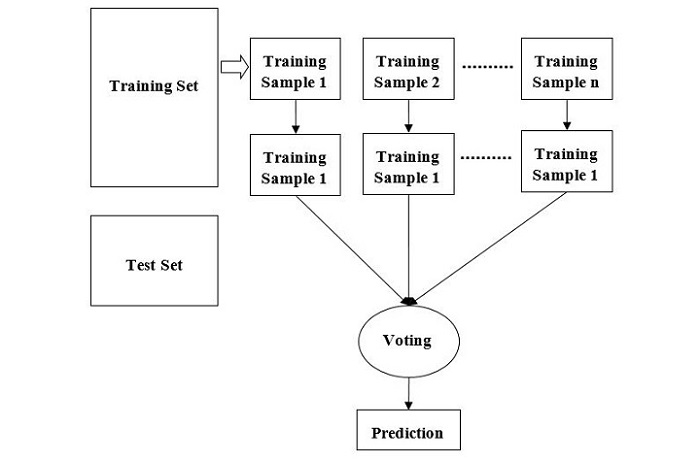
- 機器學習基礎
- ML - 首頁
- ML - 簡介
- ML - 入門
- ML - 基本概念
- ML - 生態系統
- ML - Python 庫
- ML - 應用
- ML - 生命週期
- ML - 必備技能
- ML - 實現
- ML - 挑戰與常見問題
- ML - 限制
- ML - 真實案例
- ML - 資料結構
- ML - 數學基礎
- ML - 人工智慧
- ML - 神經網路
- ML - 深度學習
- ML - 獲取資料集
- ML - 分類資料
- ML - 資料載入
- ML - 資料理解
- ML - 資料準備
- ML - 模型
- ML - 監督學習
- ML - 無監督學習
- ML - 半監督學習
- ML - 強化學習
- ML - 監督學習與無監督學習
- 機器學習資料視覺化
- ML - 資料視覺化
- ML - 直方圖
- ML - 密度圖
- ML - 箱線圖
- ML - 相關矩陣圖
- ML - 散點矩陣圖
- 機器學習統計學
- ML - 統計學
- ML - 均值、中位數、眾數
- ML - 標準差
- ML - 百分位數
- ML - 資料分佈
- ML - 偏度和峰度
- ML - 偏差和方差
- ML - 假設
- ML中的迴歸分析
- ML - 迴歸分析
- ML - 線性迴歸
- ML - 簡單線性迴歸
- ML - 多元線性迴歸
- ML - 多項式迴歸
- ML中的分類演算法
- ML - 分類演算法
- ML - 邏輯迴歸
- ML - K近鄰演算法 (KNN)
- ML - 樸素貝葉斯演算法
- ML - 決策樹演算法
- ML - 支援向量機
- ML - 隨機森林
- ML - 混淆矩陣
- ML - 隨機梯度下降
- ML中的聚類演算法
- ML - 聚類演算法
- ML - 基於質心的聚類
- ML - K均值聚類
- ML - K中心點聚類
- ML - 均值漂移聚類
- ML - 層次聚類
- ML - 基於密度的聚類
- ML - DBSCAN 聚類
- ML - OPTICS 聚類
- ML - HDBSCAN 聚類
- ML - BIRCH 聚類
- ML - 親和傳播
- ML - 基於分佈的聚類
- ML - 凝聚層次聚類
- ML中的降維
- ML - 降維
- ML - 特徵選擇
- ML - 特徵提取
- ML - 向後剔除法
- ML - 向前特徵構造
- ML - 高相關性過濾器
- ML - 低方差過濾器
- ML - 缺失值比率
- ML - 主成分分析
- 強化學習
- ML - 強化學習演算法
- ML - 利用與探索
- ML - Q學習
- ML - REINFORCE 演算法
- ML - SARSA 強化學習
- ML - 演員-評論家方法
- 深度強化學習
- ML - 深度強化學習
- 量子機器學習
- ML - 量子機器學習
- ML - 使用 Python 的量子機器學習
- 機器學習雜項
- ML - 效能指標
- ML - 自動工作流
- ML - 提升模型效能
- ML - 梯度提升
- ML - 自舉匯聚 (Bagging)
- ML - 交叉驗證
- ML - AUC-ROC 曲線
- ML - 網格搜尋
- ML - 資料縮放
- ML - 訓練和測試
- ML - 關聯規則
- ML - Apriori 演算法
- ML - 高斯判別分析
- ML - 成本函式
- ML - 貝葉斯定理
- ML - 精度和召回率
- ML - 對抗性
- ML - 堆疊
- ML - 輪次
- ML - 感知器
- ML - 正則化
- ML - 過擬合
- ML - P值
- ML - 熵
- ML - MLOps
- ML - 資料洩露
- ML - 機器學習的商業化
- ML - 資料型別
- 機器學習 - 資源
- ML - 快速指南
- ML - 速查表
- ML - 面試問題
- ML - 有用資源
- ML - 討論
機器學習 - 隨機森林
隨機森林是一種機器學習演算法,它使用決策樹的集合來進行預測。該演算法由 Leo Breiman 於 2001 年首次提出。該演算法背後的關鍵思想是建立大量的決策樹,每個決策樹都訓練於不同的資料子集。然後將這些單個樹的預測結果組合起來,以產生最終預測。
隨機森林演算法的工作原理
我們可以透過以下步驟來理解隨機森林演算法的工作原理:
步驟 1 - 首先,從給定的資料集中選擇隨機樣本。
步驟 2 - 接下來,該演算法將為每個樣本構建一棵決策樹。然後它將從每棵決策樹中獲取預測結果。
步驟 3 - 在此步驟中,將對每個預測結果進行投票。
步驟 4 - 最後,選擇得票最多的預測結果作為最終預測結果。
下圖說明了隨機森林演算法的工作原理:

隨機森林是一種靈活的演算法,可用於分類和迴歸任務。在分類任務中,該演算法使用各個樹預測結果的眾數來進行最終預測。在迴歸任務中,該演算法使用各個樹預測結果的平均值。
隨機森林演算法的優點
隨機森林演算法比其他機器學習演算法具有幾個優點。一些關鍵優勢包括:
對過擬合的魯棒性 - 隨機森林演算法以其對過擬合的魯棒性而聞名。這是因為該演算法使用決策樹的集合,這有助於減少資料中異常值和噪聲的影響。
高精度 - 隨機森林演算法以其高精度而聞名。這是因為該演算法結合了多個決策樹的預測結果,這有助於減少可能存在偏差或不準確的單個決策樹的影響。
處理缺失資料 - 隨機森林演算法可以處理缺失資料,無需進行插補。這是因為該演算法只考慮每個資料點可用的特徵,並且不需要所有資料點的所有特徵都存在。
非線性關係 - 隨機森林演算法可以處理特徵和目標變數之間的非線性關係。這是因為該演算法使用決策樹,可以模擬非線性關係。
特徵重要性 - 隨機森林演算法可以提供有關模型中每個特徵重要性的資訊。此資訊可用於識別資料中最重要的特徵,並可用於特徵選擇和特徵工程。
在 Python 中實現隨機森林演算法
讓我們來看一下在 Python 中實現隨機森林演算法的方法。我們將使用 scikit-learn 庫來實現該演算法。scikit-learn 庫是一個流行的機器學習庫,它提供了廣泛的機器學習演算法和工具。
步驟 1 - 匯入庫
我們將從匯入必要的庫開始。我們將使用 pandas 庫進行資料操作,並使用 scikit-learn 庫來實現隨機森林演算法。
import pandas as pd from sklearn.ensemble import RandomForestClassifier
步驟 2 - 載入資料
接下來,我們將資料載入到 pandas 資料框中。在本教程中,我們將使用著名的 Iris 資料集,這是一個用於分類任務的經典資料集。
# Loading the iris dataset
iris = pd.read_csv('https://archive.ics.uci.edu/ml/machine-learningdatabases/iris/iris.data', header=None)
iris.columns = ['sepal_length', 'sepal_width', 'petal_length','petal_width', 'species']
步驟 3 - 資料預處理
在我們使用資料訓練模型之前,我們需要對其進行預處理。這包括分離特徵和目標變數,並將資料分成訓練集和測試集。
# Separating the features and target variable X = iris.iloc[:, :-1] y = iris.iloc[:, -1] # Splitting the data into training and testing sets from sklearn.model_selection import train_test_split X_train, X_test, y_train, y_test = train_test_split(X, y, test_size=0.35, random_state=42)
步驟 4 - 訓練模型
接下來,我們將使用訓練資料訓練我們的隨機森林分類器。
# Creating the Random Forest classifier object rfc = RandomForestClassifier(n_estimators=100) # Training the model on the training data rfc.fit(X_train, y_train)
步驟 5 - 進行預測
訓練完模型後,我們可以使用它對測試資料進行預測。
# Making predictions on the test data y_pred = rfc.predict(X_test)
步驟 6 - 評估模型
最後,我們將使用各種指標(如準確率、精確率、召回率和 F1 分數)來評估模型的效能。
# Importing the metrics library
from sklearn.metrics import accuracy_score, precision_score,
recall_score, f1_score
# Calculating the accuracy, precision, recall, and F1-score
accuracy = accuracy_score(y_test, y_pred)
precision = precision_score(y_test, y_pred, average='weighted')
recall = recall_score(y_test, y_pred, average='weighted')
f1 = f1_score(y_test, y_pred, average='weighted')
print("Accuracy:", accuracy)
print("Precision:", precision)
print("Recall:", recall)
print("F1-score:", f1)
完整的實現示例
以下是使用 iris 資料集在 python 中實現隨機森林演算法的完整實現示例:
import pandas as pd
from sklearn.ensemble import RandomForestClassifier
# Loading the iris dataset
iris = pd.read_csv('https://archive.ics.uci.edu/ml/machine-learningdatabases/iris/iris.data', header=None)
iris.columns = ['sepal_length', 'sepal_width', 'petal_length', 'petal_width', 'species']
# Separating the features and target variable
X = iris.iloc[:, :-1]
y = iris.iloc[:, -1]
# Splitting the data into training and testing sets
from sklearn.model_selection import train_test_split
X_train, X_test, y_train, y_test = train_test_split(X, y,
test_size=0.35, random_state=42)
# Creating the Random Forest classifier object
rfc = RandomForestClassifier(n_estimators=100)
# Training the model on the training data
rfc.fit(X_train, y_train)
# Making predictions on the test data
y_pred = rfc.predict(X_test)
# Importing the metrics library
from sklearn.metrics import accuracy_score, precision_score,
recall_score, f1_score
# Calculating the accuracy, precision, recall, and F1-score
accuracy = accuracy_score(y_test, y_pred)
precision = precision_score(y_test, y_pred, average='weighted')
recall = recall_score(y_test, y_pred, average='weighted')
f1 = f1_score(y_test, y_pred, average='weighted')
print("Accuracy:", accuracy)
print("Precision:", precision)
print("Recall:", recall)
print("F1-score:", f1)
輸出
這將給出我們隨機森林分類器的效能指標,如下所示:
Accuracy: 0.9811320754716981 Precision: 0.9821802935010483 Recall: 0.9811320754716981 F1-score: 0.9811157396063056